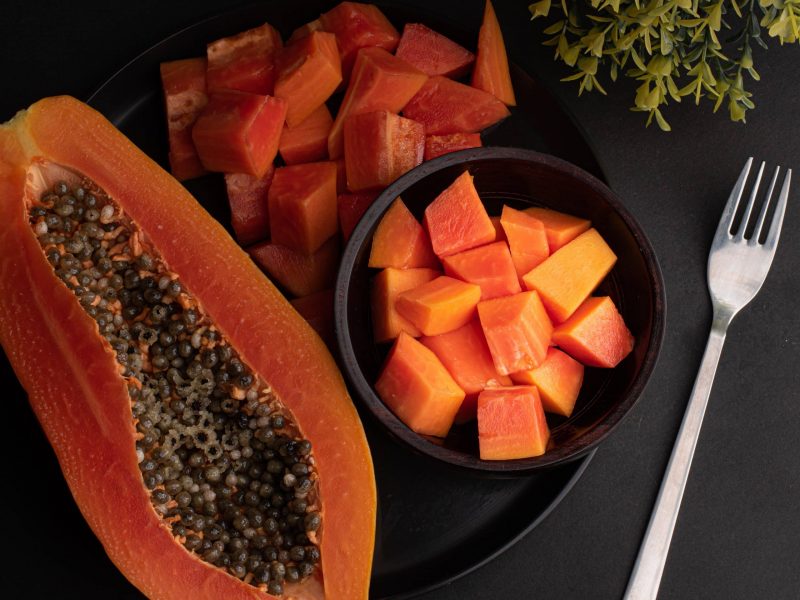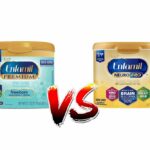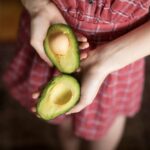As soon as you begin to feed your little one solid foods, you instantly start looking for new foods that are packed with nutritional benefits. Fruit is one of the main foods that we all try first.
We know that babies can have things like applesauce, but what about papaya? The good news is that your little one can enjoy papaya once they are old enough to eat other solid foods.
The US Food and Drug Administration has determined that papaya is safe to give to little ones, provided they are already old enough to start eating solid foods.
When Can You Give Your Baby Papaya?
It’s safe for you to give your little ones a taste of papaya as soon as they are old enough to start eating solid foods. For most children, you can safely start them on solid foods at six months.
However, you’ll want to double-check with your pediatrician before doing so. Babies that are developmentally delayed might not be able to have solid foods until they are eight or twelve months old.
When you begin to give your baby solid foods, it’s important to only give them one new food at a time in case they are allergic to a particular food.
Because allergies to papaya have been reported, you’ll need to follow the same routine when giving your baby papaya.
Give them papaya, and do not give them any other new foods for 2-3 days. If your baby develops an allergic reaction, you will know that it’s from the papaya.
Signs Of An Allergic Reaction To Papaya
When your baby is allergic to a new food that you’re trying, they will show common symptoms of being allergic to a food. Most children won’t show every symptom of having a food allergy, but they will have at least one or two. Common symptoms of a papaya allergy include:
- Itching of the mouth
- Hives
- Shortness of breath
- Swelling of the mouth or tongue
- Gastrointestinal symptoms, such as diarrhea or vomiting
Babies may also get a rash on other areas of their bodies. They may experience stomach cramps.
Unfortunately, babies can’t tell us when they have stomach cramping. You’ll notice that your little one is only fussy when they eat papaya. This is why it’s important to only give babies one new food at a time.
Benefits Of Papaya For Babies
View in gallery
Papaya is a popular fruit due to the wonderful benefits that it provides. Most people know that papaya is great for heart health, the skin, and people with diabetes, but that’s not all it’s good for. This fruit has quite a few benefits that make it wonderful for babies too!
Packed With Vitamins A And C
Papaya is packed with these two vitamins, which makes it a great food for your little one. Both of these vitamins are known for supporting the immune system.
They’ll also help your baby have healthy skin. Last, but certainly not least, the combination of these two will help your little one develop healthy eyesight that can last a lifetime.
Fiber
Papaya is a great natural source of fiber. This fruit will instantly help promote a healthy digestive system.
Your baby will experience more regular bowel movements when they have a diet with plenty of natural fiber. You’ll also notice that they have fewer incidences of diarrhea and digestive illnesses.
Plenty Of Vitamin E
When you give babies papaya, you’ll be giving them a healthy dose of Vitamin E. Vitamin E can help your baby have stronger cells. It can also:
- provide plenty of antioxidants
- promote organ health
- slow down the damage of cells
- help your baby develop healthy eyes
Vitamin E is an important part of every diet. However, it’s best to get this vitamin from natural sources, such as papaya.
How To Give Papaya To Babies
While papaya is wonderful for babies, it’s important that you know how to give papaya to your little one. Make sure that it is properly prepared before feeding it to your baby. Then, you’ll want to give it to your baby in a manner that is appropriate for their age.
Always Wash Papaya
It’s common for most fruits and vegetables to be sprayed with pesticides. This often happens before they hit the shelves in supermarkets. After you get your fresh papaya home, make sure to wash it before feeding it to your baby.
This ensures that your little one isn’t going to eat the pesticides that can linger on the outside of the fruit.
Make Sure That Papaya Is Ripe
When papaya is ripe, it’s a little bit mushy. It feels similar to when you push on a ripe tomato. Papaya that is not ripe, however, can be slippery. It will have a firm texture that makes it difficult for babies to chew. This can be a choking hazard for babies.
To make sure that papaya is ripe, push on the outside skin. It should feel slightly mushy. You can also tell by looking at the color of the skin. Green papaya is not ripe. Ripe papaya will be yellow or at least turning yellow.
How To Give Younger Babies Papaya
[amalinkspro type=”showcase” asin=”B01BEZ0PQ8″ apilink=”https://www.amazon.com/dp/B01BEZ0PQ8?tag=mominformedcom-20&linkCode=osi&th=1&psc=1″ new-window=”true” addtocart=”false” nofollow=”true” sc-id=”4″ img-sizes=”500:500″ imgs=”https://m.media-amazon.com/images/I/51qwYIAHqFL._SL500_.jpg” link-imgs=”false” specs=”Clearly Crafted: When it comes to caring for your baby, transparency is everything That’s why we bring you Clearly Crafted Our clear packaging lets you see the organic ingredients in each recipe, in all its vibrant color Its goodness you can see” btn-color=”#ff9900″ btn-text=”Check Price” alignment=”aligncenter” hide-prime=”0″ hide-image=”0″ hide-price=”0″ hide-button=”0″ width=”750″]Happy Family Happy Baby Organic Clearly Crafted Stage 2 Baby Food Bananas, Sweet Potatoes & Papayas[/amalinkspro]
Babies that are under a year old can eat papaya that is cut into quarters. Make sure that you remove seeds and skin so that your baby doesn’t choke on them. You can also make papaya pudding, puree, or papaya smoothies.
How To Give Older Babies Papaya
Once children are one year old, they can have chunks of papaya. Remove the skin and seeds as you would for younger babies.
Then, cut the papaya into bite-sized chunks. By now, your baby should be able to chew and swallow foods fine! You can also continue to make the puree, pudding, or papaya smoothies.
In Conclusion
Babies can enjoy papaya as soon as they are ready to start eating solid foods. Remember that you’ll need to feed them papaya in a manner that matches their age.
Little ones that are still eating pureed baby food will appreciate papaya pudding or puree. Babies that are older than one year old can enjoy bite-sized chunks of papaya.






